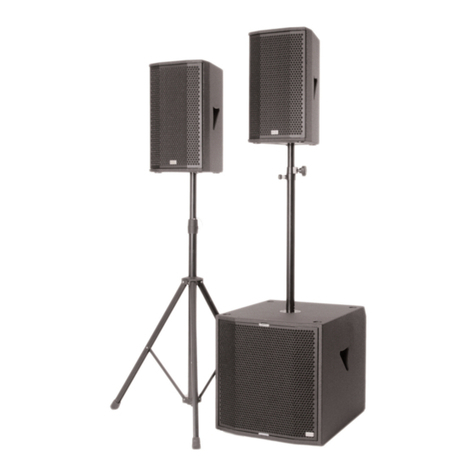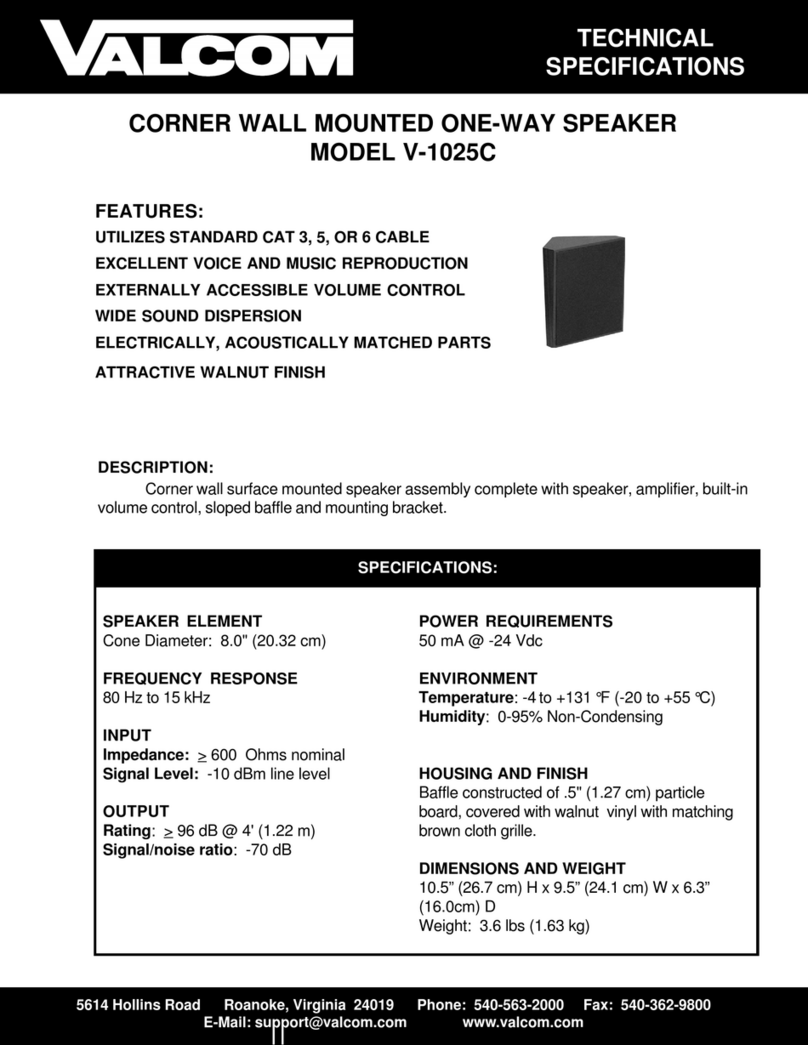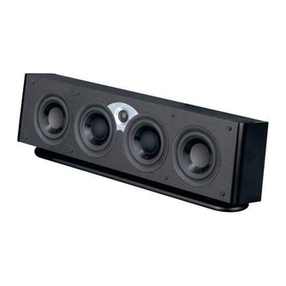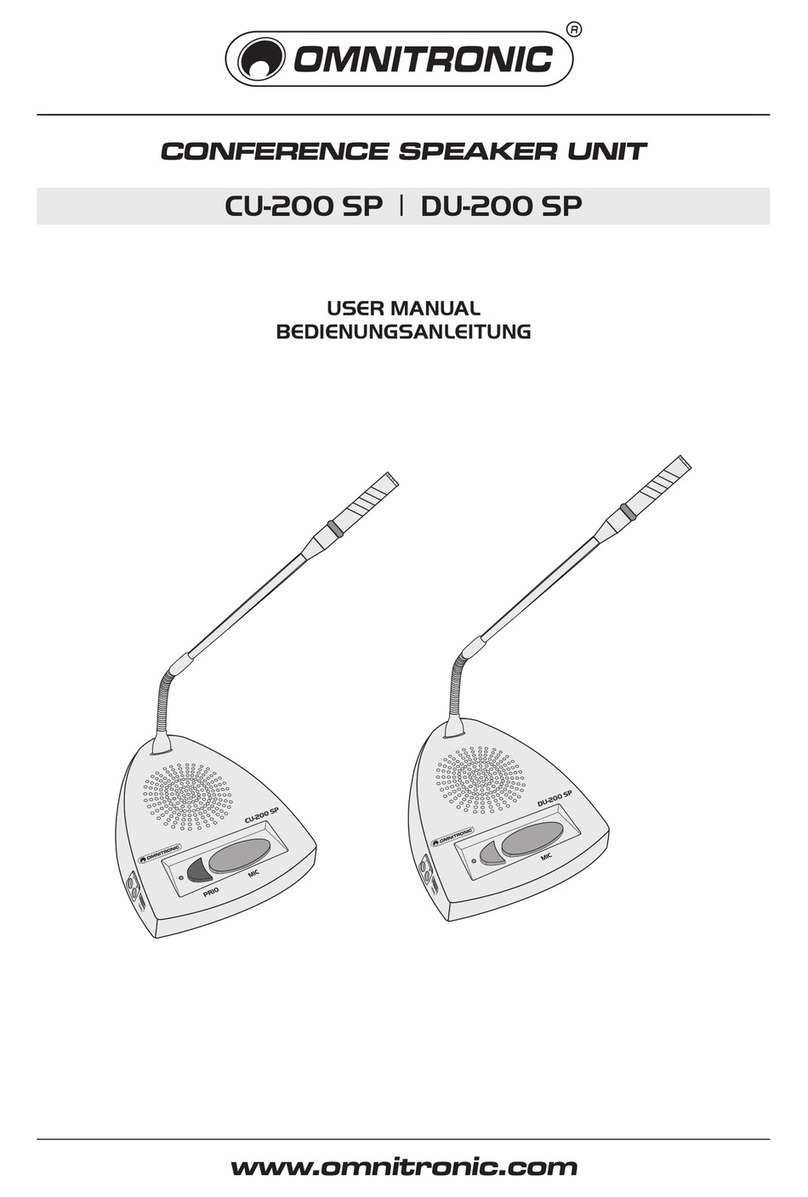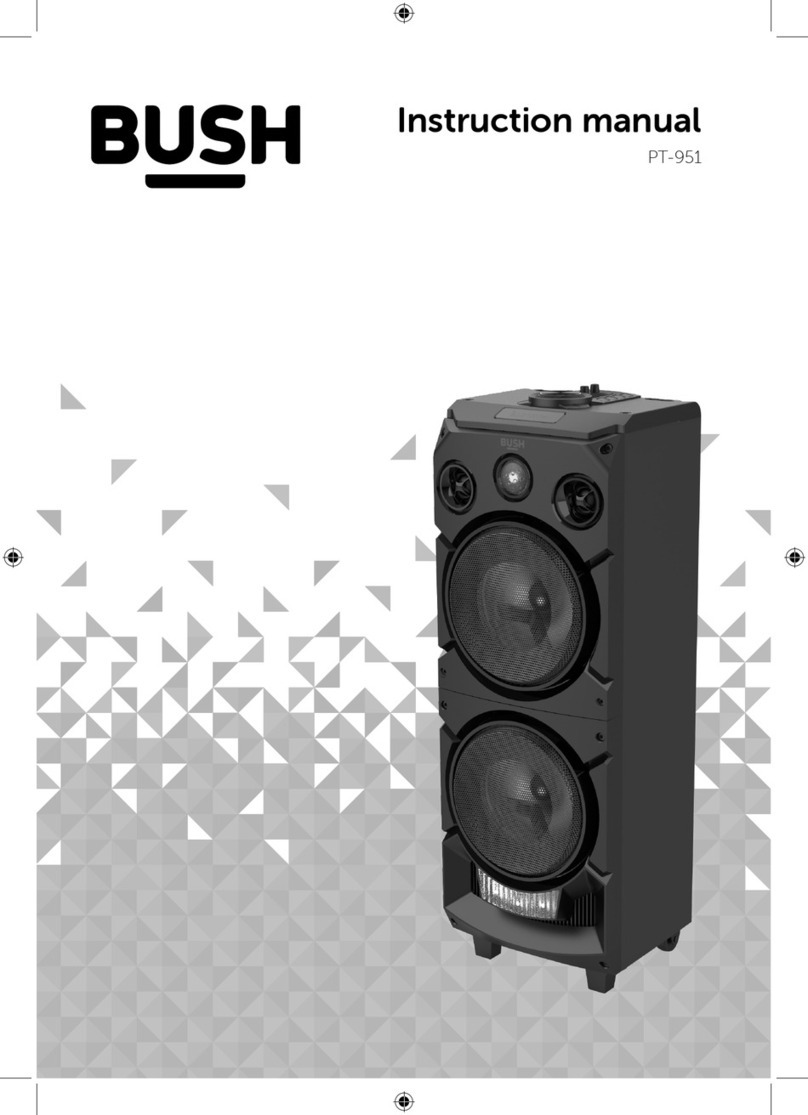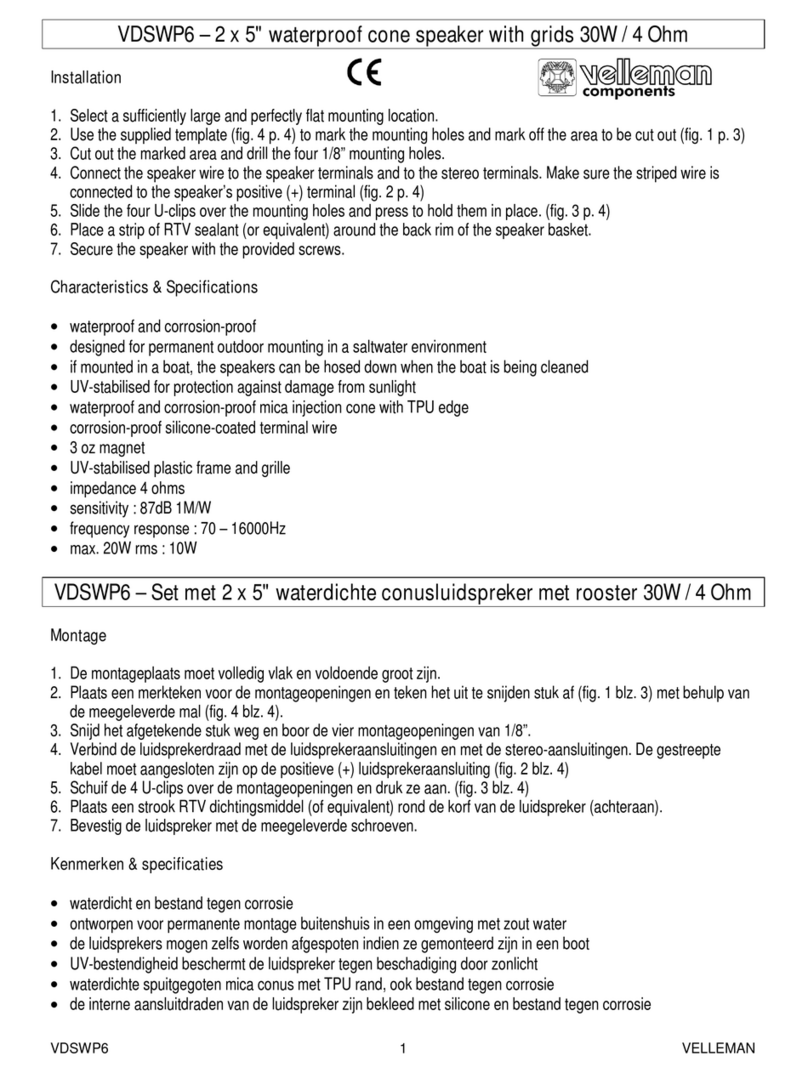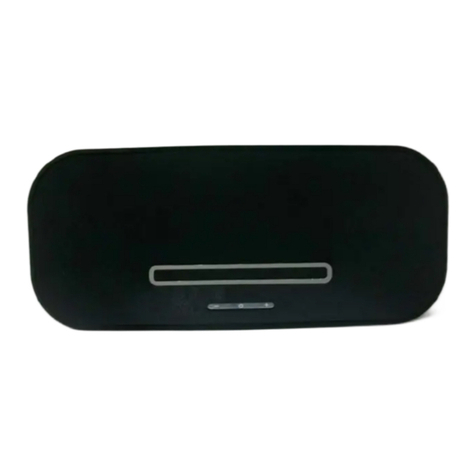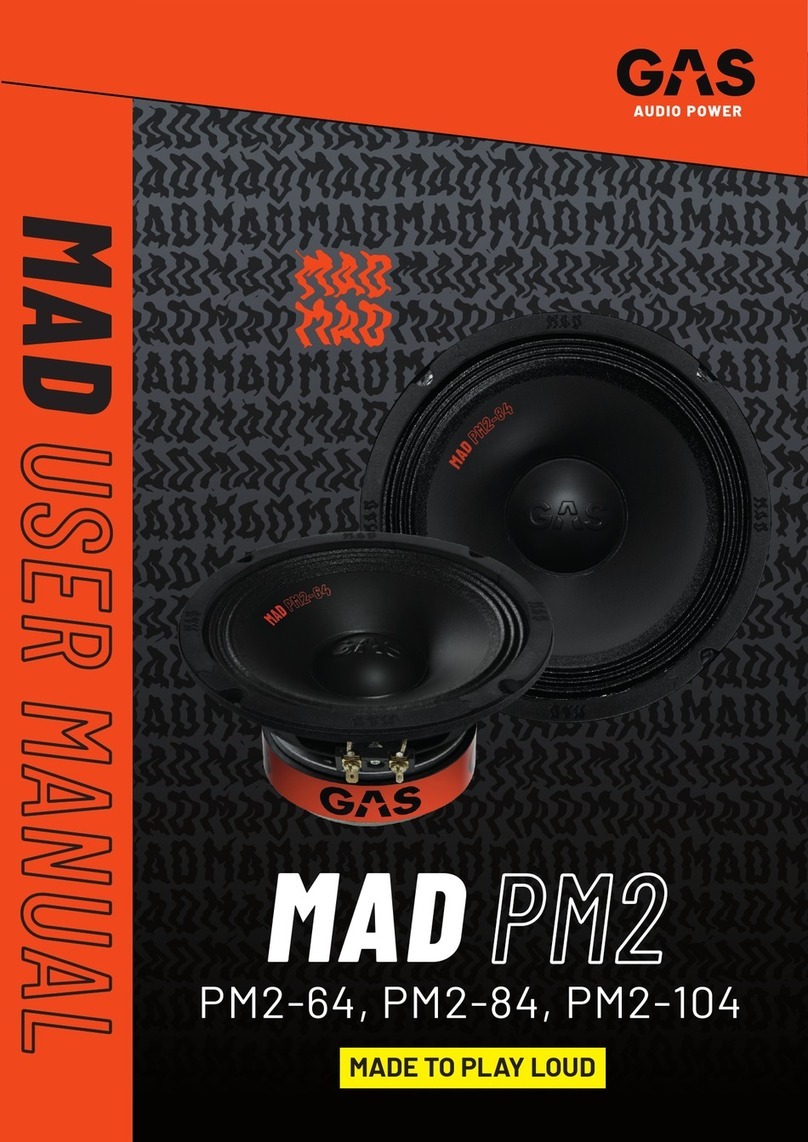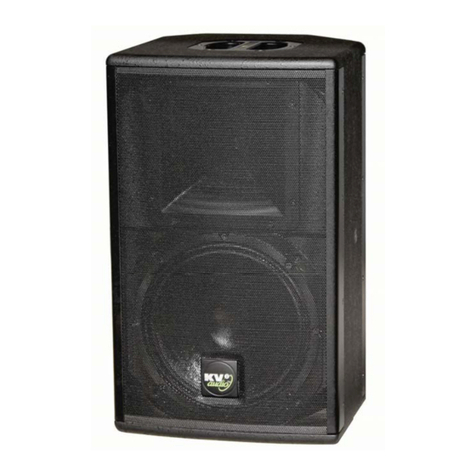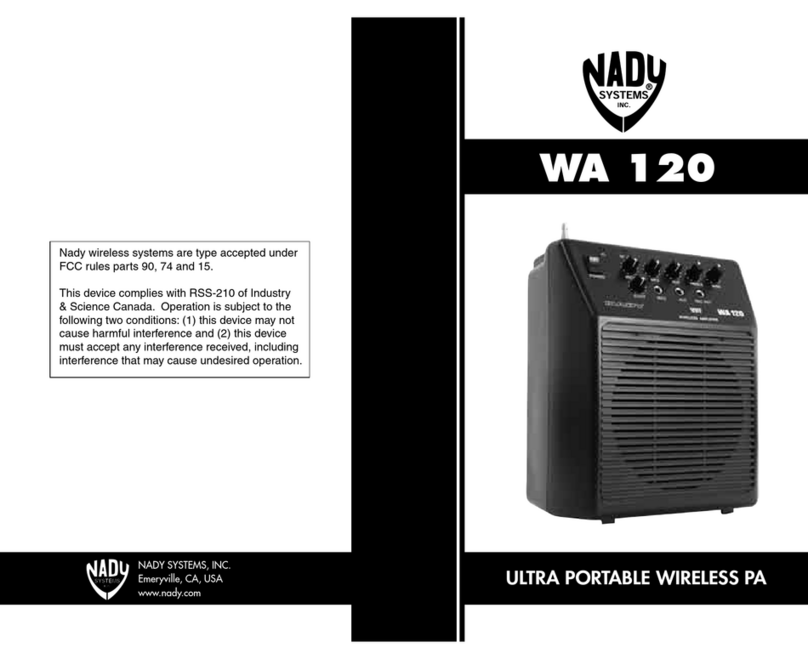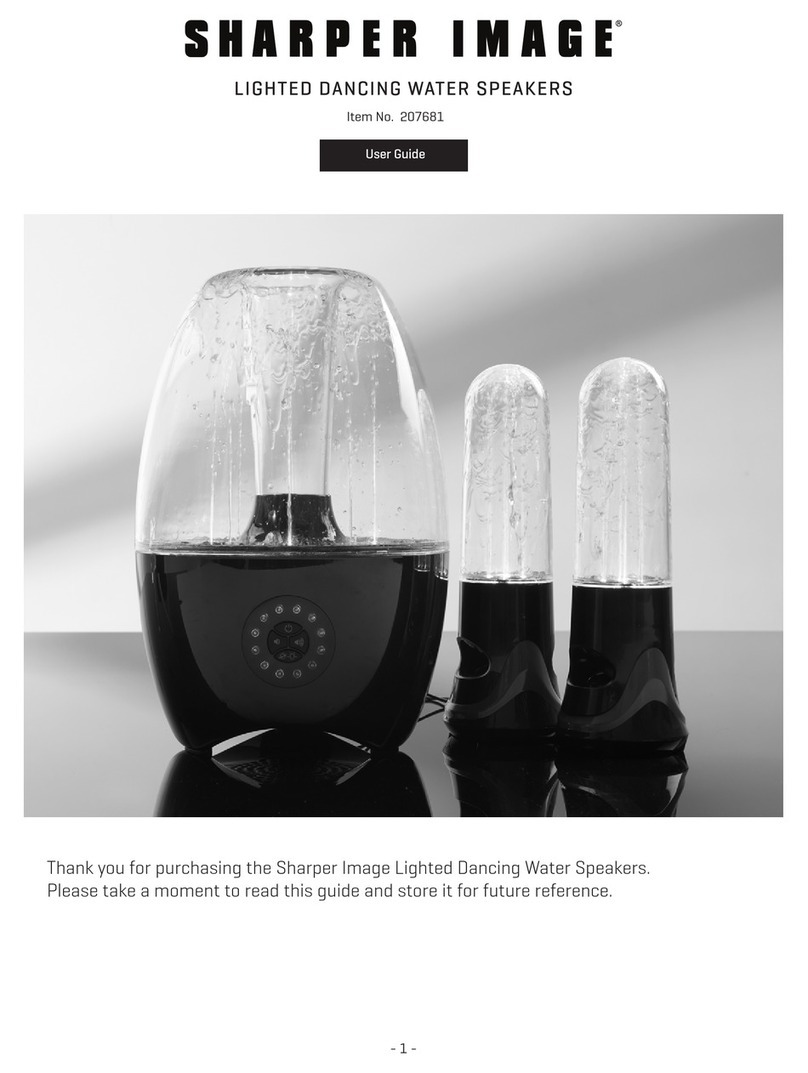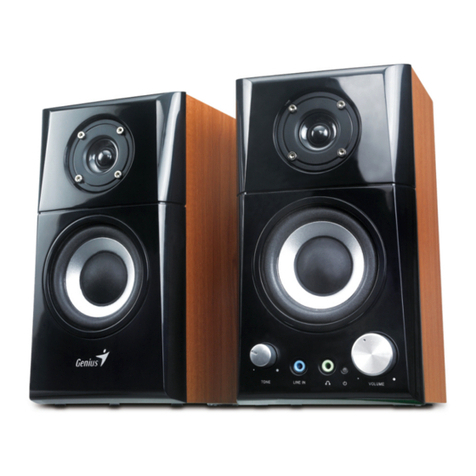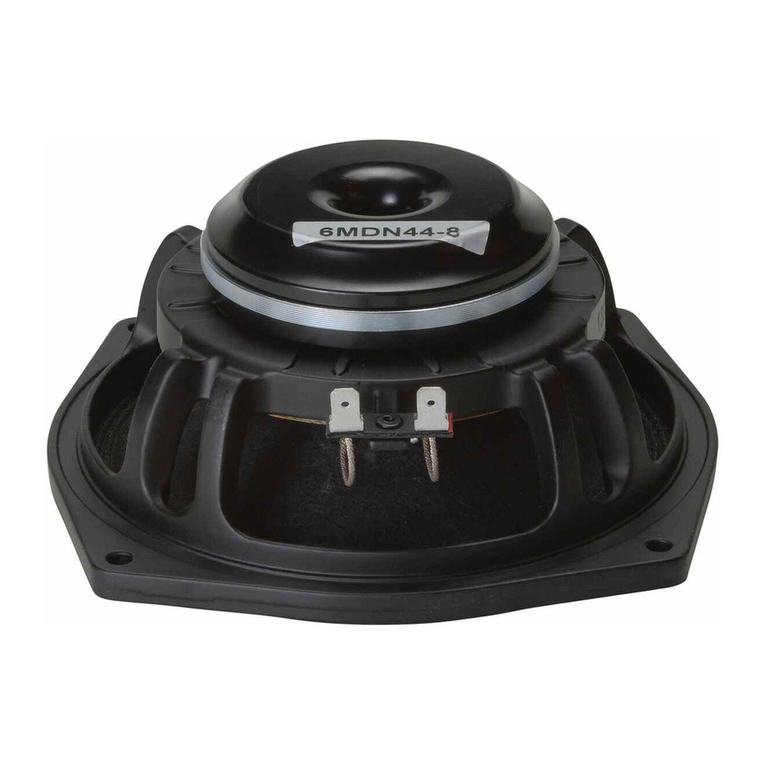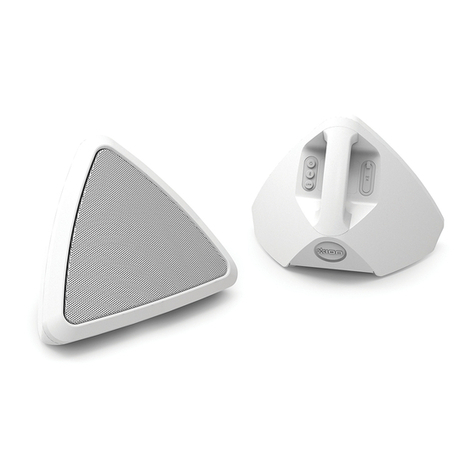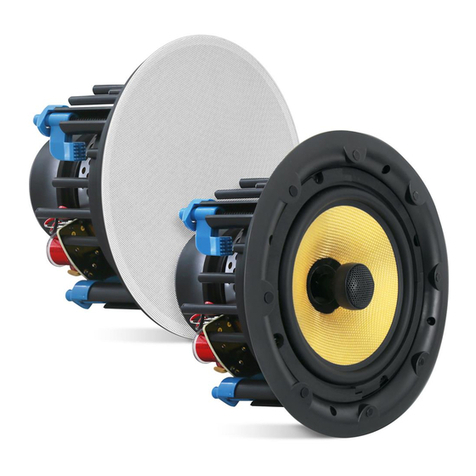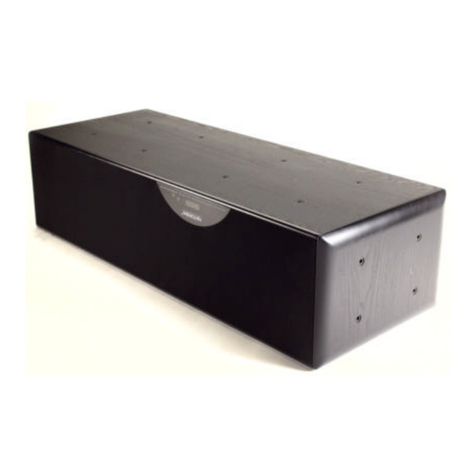KS DIGITAL ADM20 User manual

MANUAL ADM20
Gesellschaft für digitale Studiotechnik mbH
Specialists for Digital Studio Technology
ACTIVE DIGITALE
REFERENCE- STUDIOMONITOR

KSDIGITAL
GESELLSCHAFT FÜR DIGITALE STUDIOTECHNIK
AMDÖRRWALD 5
66571 EPPELBORN (DI)
E-MAIL: INFO@KSDIGITAL.DE
WWW.KSDIGITAL.DE
FURTHER INFORMATION AVAILABLE AT:
WWW.KSDIGITAL.DE
STAND: 01.06.2006
2

INHALTSVERZEICHNIS
2 CONTAKT
3 CONTENTS
4 SOUNDS RIGHT IN ROOM AND TIME
5 KSDIGITAL - FEATURES OF THE ADM - FAMILY
6- 8ADM20 - HOW IT WORKS
9ADM20 - REAR VIEW / CONTROLS
10 ADM20 - DIAGRAMS
11 ADMW - THE THIRD WAY
12 CONNETCIOS
3

SOUNDS RIGHT IN ROOM AND TIME
KSDIGITAL GESELLSCHAFT FÜR DIGITALE STUDIOTECHNIK MBH
KS DIGITAL – SPECIALIST FOR DIGITAL STUDIO TECHNOLOGY
For more than 20 years, KS has created world class sound transmission devices and has
always followed one aim; the reproduction of genuine and natural sound. KS products can
be found in the inventory of the most illustrious operas, such as the Semperoper in Vienna,
the Alte Oper in Frankfurt, Schauspiel Frankfurt, Kammerspiele in Munich or also in the
Houses of Parliament in Berlin etc., as well as in the sound studios of top artists like Stevie
Wonder, Herbert Grönemeyer, Xavier Naidoo / M. Herberger and many more. Naturally, you
will also find our products in many radio stations in Germany like SWR, SR, Hit-Radio FFH
and also around the world as well as in many famous mastering studios. The guiding principle
for the design was the ultimate aim of sound neutrality that has made the ADM products an
incorruptible tool in judging acoustic reproductions coupled with wonderful speakers to enjoy
the results of those efforts.
Many innovative ideas and patented processes have been developed by Ksdigital to get as
near as possible to the original. We developed the FIRTEC ™ technology – a digital phase
compensation filter – for the studio loudspeaker “system” (cabinet and electronic
components), with our dipole bass we have achieved a directional radiation, with DMC ™
we have built a linear phase and zero latency cone loudspeaker and with NeXT ™ we have
introduced a new technology that, especially in the area of mastering, has brought the ear
even closer to the sound and revolutionized acoustic radiation. You have made a superb
choice in buying an ADM product from KSdigital and we congratulate you on your purchase
and wish you endless enjoyment with the equipment.
ATTENTION TO THE FINEST DETAIL
During the development of the ADM family of products, we paid special attention to the
correct timing of the radiated acoustic signals. When an impulse is correctly radiated with
zero latency, this is equivalent to a linear frequency and phase characteristic. The highly
responsive drivers we use, that have been manufactured in Germany according to our
own, high specification, combine with the speed of the utilized MOSFET technology in our
amplifiers and the FIRTEC ™ digital equalization (ADM20) in an almost ideal way to achieve
our goal of sound neutrality.
(eW) : beim Patentamt München eingetragenes und geschütztes Warenzeichen
4

KSDIGITAL – FEATURES OF THE ADM PRODUCT FAMILY
All products of theADM family are compatible with each other. In this way it is possible to
combine theADM 20 orADM 30 with theADM W or operate them together in a 5.1
Surround setup.
ANALOGINPUT: Symmetrical XLR input (20dBu head room) with a bypass connector to
connect the ADM W. A blue LED indicator on the front warns of possible
overloading.
DIGITALINPUT: “FullScale” results in full volume. Warning, when connected directly to
FullScale level such as the output of a CD-player, use the remote control to
adjust the volume!
INPUT CONTROL: If the –3dB Fs limit is exceeded (-3dB under the overload limit), the blue LED
on the front will blink until the –3dB limit has been reached again. This ensures
that you can listen in safety and that overload distortion caused by levels
above the FullScale limit is eliminated. In case the FullScale level is accidentally
exceeded, a built-in limiter intercepts a dangerous overload and prevents the
destruction of the loudspeaker’s driver.
INPUT SWITCH: A dial at the rear of the cabinet enables the user to browse through a menu
with a number of adjustment parameters. If a parameter needs to be adjusted,
this is possible by pressing the dial and rotating it until the required value has
been set. In this way, under “Digital In Left” or “Digital In Right” the required
input data can be chosen for the signal processor of the DSP. If both inputs
are activated, then a mono signal is generated and reproduced.
REMOTE CONTROL:
The remote control permits a control of the volume from your work area
without a reduction of the word length of the input signal.
There are 3 types of remote control:
- per PC with remote control software
This permits access to all signal processing parameters that can
also be adjusted with the dial on the rear panel of the cabinet.
- per analogue hardware controller
This is connected to the loudspeaker and drives a VCA input signal to
control the amplification of the output stage.
-per digital hardware controller
In the same way as the PC software, this permits access to all signal
processing parameters that can also be adjusted with the dial on the rear
panel of the cabinet. 5

ADM20 THE REFERENCE CREATED BY DIGITAL PRECISION
The ADM20 is an active, two-way studio monitor for medium to high volume levels. The signal
processing, including equalization, crossover and correction of the transient behaviour of the
components, is completely done at the digital level. A connection to an existing, digital studio
environment can be made digitally using theAES3 interface. An analogue feed is however, also
possible; a high quality 27 bit gain staging, sigma-delta Converter with 64 x oversampling and a
dynamic of more than 130 dB is responsible for the conversion. The digital signal is further
processed bya fast 60MHz floatingpoint SharcDSP in our proprietarydesigned processor board.
This convertsthe 24 bitwideinput datainto a floatword with 32bit mantissaand 8Bit exponentthat
theoretically allows a dynamicof over 1500 dB; noise from overloading, scaling and rounding off
are therefore eliminated.Apatented system (Pat. Nr: 198 23 110) raisessignals with a word width
of less than 24 bits to an audiophile level. Parameters that can be externally adjusted, such as
volume, filter etc., work directly at the floating point level in the process so that also at this stage,
e.g. when adjusting the volume, no scaling errors occur. On the output side, the DSP works with
two 24 bit D/A converters feeding the high performance MOFSET output stage, that is equipped
with individually selected transistors. With a bandwidth of 100kHz and a rise time of 80 V/us, the
output stageperforms to 100W in treble range and 200Wat deep mid-range. The resulting sound
pressure is 116dB cont. and 122dB peak.
SPECIFIC FEATURES OF DIGITAL SIGNAL PROCESSING
Digital signal processing must meet the following requirements:
- Separation of the relevant signal parts into treble and bass/ mid-range as well as the 3rd way on
the analogueoutput socket
- Equalization of the transmission behaviour of each component
- Overloadprotection function
Everyanalogue interference with thesignal, - e.g. insertion of a cross-over filteror equalization of
individual speakers - causesnot onlythedesired changebutalso a change totheimpulse behaviour
of the system.Analogue equalizationwould inevitably lead to a shortimpulse beingsmudged along
the time axis and create a later oscillation of the impulse response at the end of the equalization.
Additionally,an impulse would,in turn,cause afurther oscillationdue to theinertiaof themembrane.
Putting these together cause a deformation of a right-angled input signal to a less related output
signal characteristic. The FIRTEC ™ equalizer (Finite Impulse Response) which was developed
for and is used in the ADM20, is free of those distortions described above.
6

On the contrary,the FIRTEC actually allows the processing of theLaufzeit time lapse / run time as
well as the frequency characteristic. The correction of the input signal takes place in real time by
folding theinputsignal with theimpulse response ofthe equalization filter.As opposed to analogue
technology, (that would try to correct the frequency characteristic with various filters thereby
worseningthe impulse accuracy)the equalization of theADM20 workswith adirect manipulation of
the input signal to ensure absolute accuracy of the impulse – this is physically identical with a
linearization of the frequency characteristics in Betrag value and phase. Overall, a correct impulse
behaviour is responsible for an apparent sound width (spaciousness), bass differentiation and a
correct localisation of the instruments in the room.
FREQUENCY CROSSOVER OF THE ADM20
The frequency crossover in the ADM20 works with a differential filter using FIR technology. The
high frequencies are determined as the difference between the input signal and the bass signals –
this guarantees that there is always an ideal addition in the area between high and low frequencies.
At the same time, the geometric misalignment of the moving coils of both drivers is exactly
compensated utilizing a run time circuit. When combined with the newly designed sound direction
principle of the tweeter, that ensures a planar wave at the sound opening, an optimal radiation
characteristic is guaranteed. The frequency crossover’s slope steepness of ca. 90 dB /Octave
ensures no interference when listening in front of the speaker.
EQUALIZATION OF THE ADM20
To ensure the best possible equalization of the whole system, the FIR filter works on both tweeter
and bass (complete filter) – including therefore, the transition band between both. The measurements
required to adjust the FIRTEC coefficients, take place on the complete speaker system, including
crossover set-up of the drivers, so that the corrections include the complete geometry of the system.
This procedure allows an individual calibration of the system after local installation. This means
that any peculiarities of the monitoring room can be adjusted for in the configuration of the FIRTEC
equalizer. The factory default settings of the FIRTEC filter result from measurements in an
acoustically inert room whereby each individual (!) driver is calibrated. In this way, all manufacturing
tolerances have already been compensated for in the calibration. Of course, the perfect impulse
reproduction is supported by all utilized drivers. With a Qts of the mid-/bass speaker of 0.24 long
stroke and high driving power, is a distortion free reproduction of the loudest impulse peaks
guaranteed just in the same way as with the 44mm membrane diameter of the ring-radiator tweeter.
7

SOUND RADIATION
Just as important as a correct amplitude and phase in the frequency
characteristic isanexact sound radiation,where the acousticenergy is radiated
uniformly across the complete frequency range. The new principle of directing
the sound of the tweeter, guarantees a
planar wave at the sound opening. The
built-on wave-guide then bundles the
radiated sound in exactly the same way
as the midrange/bass speaker does in its
transitionband tothetweeter, guaranteeing
a constant radiation behaviour at the
crossover frequency. The driver of this
tweeter, which is capable of high sound
pressure, works with a membrane in ring
form.Opposed tonormal dome speakers,
usually found in hifi and studio systems,
this enablesthe tweeter a distortionfree reproduction of impulsepeaks even at
very high volumes. The result of the correct digital equalization is neither
corrupted nor nullified by the drivers’ components. In case of a complete overload
of the input signal, utilization of a limiter in each path protects the components
from destruction.
8
THE 3RD WAY
A special feature of a two-way loudspeaker is the three-way processing of the
signal. In addition to the two-ways which are fed to the drivers via the built in
amplifiers, the DSP of the ADM20 calculates a third way in order to reproduce
the bass range. This extends the bass range to the lower frequency limit of 25
Hz. This bass signal can be accessed at the analogue output socket and be
connected directly to the ADMW. If the ADM20 “WooferMode” in the parameter
menu is turned to ON, then this output will be switched from “bypass” to “ADM
equalization”. Thereby, all frequencies under 100Hz are redirected to the ADMW
which naturally contributes to relieving the 8” drivers. Therefore, the combination
of the ADM20 and ADMW not only reaches the lowest frequencies but can
significantly increase the volume of higher frequencies. Spitzenabhörlautstärke.
The signal at the analogue output socket can naturally also be adjusted from the
remote control.

Digital IN, OUT
Parameter adjustment dial with
two-line display
Remote Control IN
Fused mains socket
Main switch
9
Remote Control OUT
Analogue
IN, OUT

Impulse respons without FIRTEC process Impuls response after FIRTEC process
Frequency of ADM20
with FIRTEC (red)
Frequency of ADM20
wthout FIRTEC (green)
Phase response of
ADM20
wiht FIRTEC (red)
Phase response of ADM20
wihtout FIRTEC (green)
10

Inconnectionwith theADMW,thethree-way combination
of ADM20 / ADM W forms a perfectly matched studio
monitor, that can effortlessly reproduce very high
volumes across the whole transmission range from
25Hz to 20000 Hz. With its connection at the analogue
output socketof theADM20 wherethe corrective signal
processing takes place, the ADMW is an integrated
componentenabling allpossibilities ofparameter control
such asfiltering, volume, digital connection etc.The KS
MOSFET output stage with its ca. 500 Watt, offers
enough reserves for the deepest and fullest bass,
distinguishing itself witha lively impulse. Inthis way you
can enjoy the bass section just as it was recorded with
no artificialbass generated by the loudspeaker itself.
To connect the ADMW to the ADM20:
- turn “Woofer Mode” to ON (Parameter menu of the
ADM20)
- connect the analogue output socket with the ADMW
ADMW THE THIRD WAY
OVERVIEW OFTHE TECHNICAL SPECIFICATION OF THEADM W
Connectionvia theAnalogue OUT socket of theADM20
Analogue IN,OUT: XLR-symmetrical, active bypass connector
RoomEqualization: per DSP inADM20
Drivers: 2 x 10” high performance speakers
Output Stage: 400 Watt MOSFET technology
Sound Pressure: 122dB cont. / 128dB peak
(ADM20/W Stereo set-up)
Dimensions (ADM W): 65 x 30 x 90cm 42Kg
11

DIGITAL CONNECTIONS
TheADM20utilizesdifferentleftandrightloudspeaker
cabinets. Thedifferentiation is simpledueto thedif-
ferent geometryof the speakers. Theright speaker
has the name plate with the blue LED on the right,
the left speaker’s is on the left. The different geometry
is due to the directional optimisation. In this position,
the tunnel not facing the listening position, causes
far fewer reflections.
In a studio environment, a digital connection is made
by connecting the AES signal with the Digital IN
socket of the ‘right’ speaker. The left speaker
is connected to the active Digital OUT socket
of the first speaker. The digital source must be
connected to the speaker with the ‘right digital
In’ in paramter menue. Bild1: RightADM20 Speaker
OVERVIEW OFTHETECHNICAL SPECIFICATION OFTHEADM20
AD / DA: 27 bitgain staging sigma delta, 64x over-sampling
Digital IN, OUT: AES3 Format, 32 –110 KHz
XLR symmetric, active bypass connector
Analogue IN, OUT: XLR symmetric, active bypass connector with signal selection
DSP: High performance Sharc Processor
60 MHz, 32 bit floating point, 1500dB dynamic
1500 dB dynamic
Process: FIRTEC ™ equalization, FIR crossover
limiter, preset equalization, user defined equalization, digital floating
point, volume control, deflection protection
Room Equalization: 2 x FIRTEC ™ preset, low and high shelving, 3 x parametric EQs,
phase shifting
Drivers: 2” ring radiator, 8” carbon bass
Output Stage: 200W + 100W MOSFET technology
Sound Pressure: 116dB cont. /122dB peak
Remote Control: optional, with gain control and input switch.
Dimensions: 42 x 30 x 33 cm 19.7Kg
12

digital source
ADM20 DIGITAL CONNECTION, REMOTE CONTROL
Remote Control
13
to RC socket of
next ADM20
to next ADM20 Digital IN in connetcion with ADMW:
- toAnalogue -In Buchse ofsADMW
- Woofer Mode in menue of: ON

Description Function Range of Values
Volume Total volume 0dB … -31dB
Filter 1
Frequency X/26 Frequency band of Filter 127 frequency bands
Gain Relative level of the correction filter +6dB … -6dB
Q-Factor Frequency bandwidth 0.1,…, 5.0
Filter 2
Frequency X/26 Frequency band of Filter 127 frequency bands
Gain Relative level of the correction filter +6dB … -6dB
Q-Factor Frequency bandwidth 0.1,…, 5.0
Filter 3
Frequency X/26 Frequency band of Filter 127 frequency bands
Gain Relative level of the correction filter +6dB … -6dB
Q-Factor Frequency bandwidth 0.1,…, 5.0
Low shelving 80Hz EQ +6dB … -6dB
High shelving 12kHz EQ +6dB … -6dB
Distance shift Speaker delay In meter
Subwoofer Switches between 20Hz and 35Hz fgu Active / Not active
Phase reversal Phasing shift of 180° Active / Not active
Digital In Left Turns on left data word Active / Not active
and turns off analogue input
Digital In Right Turns on right data word Active / Not active
and turns off analogue input
Update FIR Filter Facilitates transfer of a new filter Active / Not active
The 27 frequency bands (terz bands) appear in the display in the following order:
40 Hz, 50 Hz, 63Hz, 80Hz, 100 Hz, 125 Hz, 160 Hz, 200 Hz, 250 Hz, 315 Hz, 400 Hz, 500 Hz,
630 Hz, 800 Hz, 1000 Hz, 1250 Hz, 1600 Hz, 2000 Hz, 2500Hz, 3150 Hz, 4000 Hz, 6300 Hz,
8000 Hz,10000 Hz, 12500 Hz, 16000 Hz.

PC Screen shot of the ADMControl Software
Other KS DIGITAL Speakers manuals

